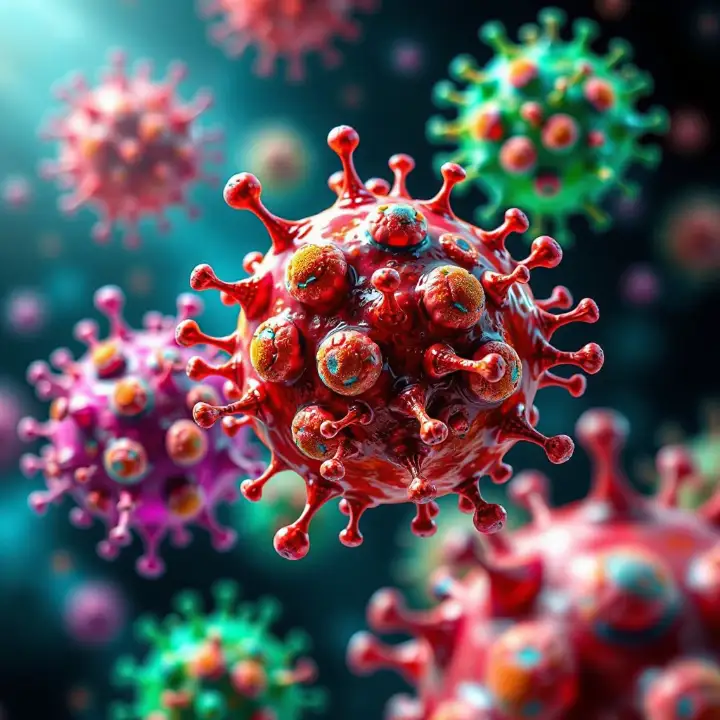Medullary Carcinoma Explained and Key Features Unveiled

Medullary carcinoma is a rare type of cancer that stands out due to its unique features. It originates in specific tissues, such as the thyroid gland or breast, and often exhibits distinct cellular patterns under a microscope. Unlike other cancers, it tends to grow in a well-defined area, making it easier to identify in some cases. You might notice its slower spread compared to other aggressive cancers. Understanding its characteristics can help you recognize its signs early and seek timely medical advice.
Key Takeaways
Surgery is the main way to treat medullary carcinoma. It works best for thyroid cases. Acting early helps recovery.
Changes in the RET gene often cause medullary carcinoma. Knowing your genetic risks can help prevent and treat it.
Regular scans are important for tumors without symptoms. They find changes early and help control the disease.
Using both radiation and chemotherapy has helped some patients fully recover. This shows how new treatments can work well.
Staying healthy is important for feeling good overall. Don’t smoke, eat healthy foods, and follow your doctor’s advice.
What Is Medullary Carcinoma?

Definition and Overview
Medullary carcinoma is a rare type of cancer with distinct histological features. It is often categorized within the subgroup of basal-like carcinomas, which are known for their heterogeneity in morphology and behavior. Researchers have proposed a simplified definition of medullary-like carcinoma, linking it to a better prognosis in triple-negative basal-like cancers. This type of cancer stands out due to its unique cellular patterns and its association with specific genetic mutations.
Origin and Affected Areas
This cancer originates in specific tissues, most commonly the thyroid gland or breast. In the thyroid, it develops from parafollicular C cells, which produce the hormone calcitonin. In the breast, it is often linked to basal-like carcinomas and may share features with tumors found in individuals carrying BRCA1 mutations. Medullary carcinoma can also appear in other areas, but these cases are less common. Its growth pattern often remains localized, which can make it easier to detect in its early stages.
Unique Features Compared to Other Cancers
Medullary carcinoma exhibits several unique histological and molecular features that set it apart from other cancers. These include:
Histological Feature | Description |
|---|---|
Prominent inflammation | Better prognosis when present in at least 30% of the tumor. |
Anastomosing sheets | Found in at least 30% of the tumor, linked to improved outcomes. |
Absence of fibrosis | Typically lacks fibrosis, unlike many other cancers. |
Absence of infiltrative margin | Does not show the infiltrative growth seen in other types. |
Absence of gland formation | Lacks glandular differentiation, a key distinguishing feature. |
Ridolfi criteria | Includes syncytial sheets, mononuclear infiltrate, and circumscribed edges. |
Association with BRCA1 mutations | Shares features with BRCA1-related tumors, often linked to a poor prognosis. |
These features help pathologists identify medullary carcinoma and differentiate it from other types of cancer. Its lack of gland formation and fibrosis, along with its circumscribed growth, are particularly notable.
Key Characteristics of Medullary Carcinoma

Symptoms
Common Symptoms
You may notice symptoms that vary depending on the location of medullary carcinoma. In the thyroid, common signs include a lump in the neck, difficulty swallowing, or changes in your voice. If the cancer affects the breast, you might feel a firm, well-defined mass that doesn’t cause pain. Fatigue and unexplained weight loss are also frequent symptoms. These signs often appear early, making it crucial to seek medical advice promptly.
Advanced or Rare Symptoms
In advanced stages, medullary carcinoma can cause more severe symptoms. For thyroid cases, high levels of calcitonin may lead to diarrhea or flushing of the skin. If the cancer spreads to other organs, you might experience bone pain, breathing difficulties, or neurological issues. These symptoms are less common but indicate the need for immediate medical attention.
Causes and Risk Factors
Genetic Factors
Genetic mutations play a significant role in medullary carcinoma. In hereditary medullary thyroid carcinoma (HMTC), mutations in the RET gene, particularly in exons 10 and 11, are common. The codon 634 mutation in exon 11 accounts for 85% of cases. In MEN2B, the M918T mutation in exon 16 is present in 95% of cases and is linked to a severe prognosis. Additionally, mutations in the RAS gene family, such as HRAS, occur in tumors with wild-type RET status.
Environmental and Lifestyle Factors
While genetics are a primary cause, environmental and lifestyle factors may also contribute. Exposure to radiation, especially during childhood, increases the risk of thyroid cancers, including medullary carcinoma. Smoking and a diet low in iodine can further elevate the risk. Maintaining a healthy lifestyle and avoiding known carcinogens can help reduce your chances of developing this cancer.
Diagnosis
Imaging Techniques
Doctors use advanced imaging techniques to diagnose medullary carcinoma and assess its spread. Common methods include:
CT Scans: These scans evaluate the chest, abdomen, and pelvis, providing a clear view of lymph nodes and potential metastases.
MRI Scans: These are particularly effective for detecting thyroid cancer and its spread to the brain or spinal cord.
PET/CT Scans: This combination helps identify cancer recurrence or extensive lymph node involvement.
Biopsy and Pathology
A biopsy remains the gold standard for confirming medullary carcinoma. During this procedure, a small tissue sample is taken and examined under a microscope. Pathologists look for unique features like syncytial sheets and the absence of gland formation to confirm the diagnosis.
Blood Tests and Biomarkers
Blood tests play a vital role in diagnosing and monitoring medullary carcinoma.
Evidence Description | Role in Diagnosis and Monitoring |
|---|---|
Measurement of calcitonin in the blood can determine if medullary thyroid cancer is still present and growing. | It serves as a minimally invasive monitoring tool for patients post-surgery. |
A rise in calcitonin or CEA levels after being low indicates cancer recurrence. | This is critical for assessing the effectiveness of treatment and the potential return of the disease. |
CEA is produced in significant amounts by most patients with medullary thyroid cancer. | Its detection in blood tests is an important marker for diagnosing the disease. |
These tests provide valuable insights into the presence and progression of the disease, helping doctors tailor treatment plans effectively.
Treatment Options for Medullary Carcinoma
Surgical Interventions
Surgery is the cornerstone of treatment for medullary carcinoma, especially in cases involving the thyroid gland. Doctors often recommend a total thyroidectomy, which removes the entire thyroid gland. This procedure is usually paired with central neck nodal dissection to eliminate lymph nodes in the immediate area. In some cases, functional lateral neck nodal dissections are also performed to address cancer that has spread further. These surgical approaches aim to improve your chances of recovery and reduce the risk of recurrence. Early and precise surgical intervention plays a critical role in managing this disease effectively.
Radiation Therapy
Radiation therapy can be an important option for treating medullary carcinoma, particularly when surgery is not feasible or the cancer has spread. It uses high-energy rays to target and destroy cancer cells. Studies have shown that combining radiation therapy with chemotherapy can yield better results for patients with limited disease spread. For example:
Patients treated with both radiation and chemotherapy have achieved complete cancer remission in some cases.
Some individuals remained disease-free for over a year following this combined approach.
However, radiation therapy alone may not always prevent disease progression. Your doctor will evaluate your specific case to determine if this treatment is suitable for you.
Chemotherapy
Chemotherapy involves the use of drugs to kill cancer cells or stop their growth. It is often used when medullary carcinoma has spread to other parts of the body. This treatment can be administered orally or intravenously, depending on the drugs prescribed. While chemotherapy may not always cure the disease, it can help shrink tumors and alleviate symptoms. Advances in chemotherapy continue to improve its effectiveness, offering hope for better outcomes.
Targeted Therapy
Targeted therapy has revolutionized the treatment of medullary carcinoma by focusing on specific genetic mutations and pathways. Unlike traditional chemotherapy, these therapies aim to block cancer growth with minimal damage to healthy cells. One of the most significant advancements involves selective RET kinase inhibitors, such as selpercatinib and pralsetinib. These drugs target RET mutations, which are common in medullary carcinoma, offering a more precise and effective treatment option.
Selpercatinib, approved for RET-mutant medullary carcinoma, has shown remarkable results in clinical trials.
The LIBRETTO-531 trial demonstrated its superiority over traditional therapies.
Patients experienced fewer side effects and better outcomes compared to older treatments.
Therapy | Progression-Free Survival Rate | Overall Response Rate |
|---|---|---|
Selpercatinib | 69.4% | |
Comparator Group | N/A | 38.8% |
These therapies not only improve survival rates but also enhance the quality of life for patients. By reducing adverse reactions, they allow you to manage the disease more comfortably.
Emerging Treatments
Researchers are exploring innovative approaches to treat medullary carcinoma. These emerging treatments focus on molecular genetics, immunotherapy, and advanced diagnostic tools like liquid biopsies.
Molecular Genetics: Studies show that suppressing miR-200b and miR-200c in cancer cells reduces invasiveness and improves cellular viability.
Immunotherapy: CD276 has been identified as a promising target. Combining immunotherapy with other treatments may enhance effectiveness.
Liquid Biopsy: Circulating miRNAs are being studied as non-invasive biomarkers. These could help detect medullary carcinoma early and monitor treatment responses.
Evidence Type | Description |
|---|---|
Molecular Genetics | Suppression of miR-200b and miR-200c reduces invasiveness in cancer cells. |
Immunotherapy | CD276 is a potential target for combination therapies. |
Liquid Biopsy | Circulating miRNAs aid in early detection and treatment monitoring. |
These advancements bring hope for more effective and less invasive treatment options in the future.
Prognosis and Outlook for Medullary Carcinoma
Survival Rates
The survival rates for medullary carcinoma vary depending on factors like early detection and treatment success. On average, the 5-year survival rate is 85.7%, while the 10-year survival rate is 78.4%. Patients who achieve a biochemical cure, where no detectable cancer markers remain in the blood, have a significantly higher 10-year survival rate of 97.7%. For those who do not achieve a cure, the survival rates drop to 80.2% at 5 years and 70.3% at 10 years.
Time Frame | Survival Rate (%) |
|---|---|
5 years | 85.7 +/- 1.5 |
10 years | 78.4 +/- 2.1 |
Non-cured (5 years) | 80.2 +/- 2.2 |
Non-cured (10 years) | 70.3 +/- 2.9 |
Biochemical Cure | 97.7 (10 years) |
These statistics highlight the importance of early diagnosis and effective treatment in improving outcomes.
Factors Influencing Prognosis
Several factors play a critical role in determining your prognosis. Younger age at diagnosis and early-stage detection often lead to better outcomes. The extent of nodal disease and the presence of metastases significantly impact survival rates. Additionally, the type and extent of surgery performed can influence long-term results.
Factor | Influence on Prognosis |
|---|---|
Age at diagnosis | Significant |
Extent of nodal disease | Significant |
Extent of surgery | Significant |
Presence of metastases | Significant |
Independent predictors of prognosis include age and cancer stage, while gender and type of surgery are considered univariate predictors. Understanding these factors can help you and your doctor make informed decisions about your treatment plan.
Quality of Life Considerations
Living with medullary carcinoma can affect your quality of life, but advancements in treatment and supportive care have made it easier to manage. Treatments like targeted therapy often have fewer side effects, allowing you to maintain daily activities. Regular follow-ups and monitoring can help detect any recurrence early, giving you peace of mind. Emotional support from family, friends, or support groups can also improve your mental well-being. By staying proactive and informed, you can navigate life with medullary carcinoma more confidently.
Medullary carcinoma is a rare cancer with distinct features and symptoms that vary by location. Key takeaways include:
Surgery remains the primary treatment, especially for medullary thyroid carcinoma.
Advanced cases may require tyrosine kinase inhibitors like cabozantinib or vandetanib.
Asymptomatic metastatic tumors benefit from regular imaging every 6 to 12 months.
Recent advancements, such as combining radiation therapy with chemotherapy, have shown promising results. Studies reveal that some patients achieve complete remission and remain disease-free for over a year. These breakthroughs highlight the importance of early detection and ongoing research in improving outcomes.
FAQ
What makes medullary carcinoma different from other cancers?
Medullary carcinoma stands out due to its unique cellular patterns and genetic links. It often grows in a well-defined area and lacks gland formation or fibrosis, which are common in other cancers. These features make it easier to identify under a microscope.
Can medullary carcinoma be hereditary?
Yes, hereditary forms exist, especially in medullary thyroid carcinoma. Mutations in the RET gene often cause these cases. If you have a family history of this cancer, genetic testing can help assess your risk.
How is medullary carcinoma diagnosed?
Doctors use imaging techniques, biopsies, and blood tests to diagnose medullary carcinoma. Blood tests often measure calcitonin and CEA levels, which act as biomarkers for this cancer. These methods help confirm the diagnosis and guide treatment.
Is medullary carcinoma curable?
Early detection and treatment improve the chances of a cure. Surgery is the most effective option, especially for localized cases. Advanced treatments like targeted therapy also offer hope for managing the disease and improving outcomes.
What lifestyle changes can help manage medullary carcinoma?
Adopting a healthy lifestyle supports your overall well-being. Avoid smoking, eat a balanced diet, and follow your doctor’s recommendations. Regular follow-ups and monitoring ensure early detection of any recurrence, helping you stay proactive in managing your health.
---
ℹ️ Explore more: Read our Comprehensive Guide to All Known Cancer Types for symptoms, causes, and treatments.
See Also
Essential Insights About Carcinoid Tumors You Must Understand
Key Characteristics Of Glioblastoma You Need To Know
Cholangiocarcinoma: Important Features You Should Be Aware Of
Crucial Information About Ganglioneuromas You Should Learn
Islet Cell Carcinoma: Key Details About This Pancreatic Cancer
